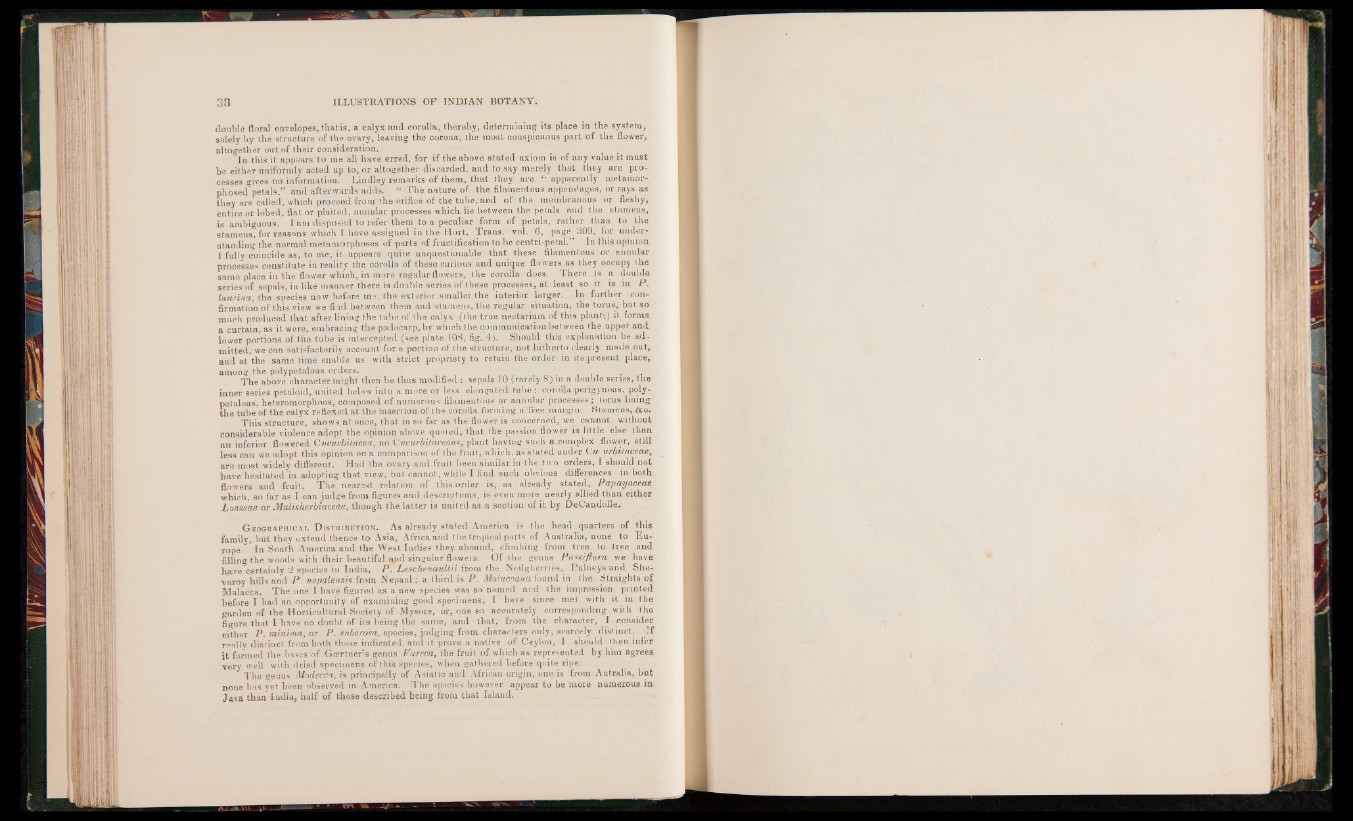
double floral envelopes, that is, a calyx and corolla, thereby, determining its place in the system,
solely by the structure of the ovary, leaving the corona, the most conspicuous part of the flower,
altogether out of their consideration.
In this it appears to me all have erred, for if the above stated axiom is of any value it must
be either uniformly acted up to, or altogether discarded, and to say merely that they are processes
gives no information. Lindley remarks of them, that they are “ apparently metamorphosed^
petals,” and afterwards adds. “ The nature of- the filamentous appendages, or rays as
they are called, which proceed front the orifice of the tube, and of the membranous or fleshy,
entire or lobed, flat or plaited, annular processes which lie between the petals and the stamens,
is ambiguous. I am disposed to refer them to a peculiar form of petals, rather than to the
stamens, for reasons which I have assigned in the Hort. Trans, vol. 6, page 309, for understanding
the normal metamorphoses of parts of fructification to be centri-petal.” In this opinion
1 fully coincide as, to me, it appears quite unquestionable that these filamentous or annular
processes constitute in reality the corolla of these curious and unique flowers as they occupy the
same place in the flower which, in more regular flowers, the corolla does. There is a double
series of sepals, in like manner there is double series of these processes, at least so it is in P.
laurina, the species now before rne, the exterior smaller the interior larger. In further confirmation
of this view we find between them and stamens, the regular situation, the torus, but so
much produced that after lining the tube of the calyx (the true nectarium of this plant*,) it forms
a curtain, as it were, embracing the podocarp, by which the communication between the upper and
lower portions of the tube is intercepted (see plate 108, fig. 4). Should this explanation be admitted,
we can satisfactorily account for a portion of the structure, not hitherto clearly made out,
and at the same time enable us with strict propriety to retain the order in its present place,
among the polypetalous orders.
The above character might then be thus modified : sepals 10 (rarely 8) in a double series, the
inner series petaloid, united below into a more or less—elongated tube: corolla-perigynous, polypetalous,
heteromorphous, composed of numerous filamentous or annular processes; torus lining
the tube of the calyx reflexed at the insertion of the corolla forming a free margin. Stamens, &c.
This structure, shows at once, that in so far as the flower is concerned, we cannot without
considerable violence adopt the opinion above quoted, that the passion flower is little else than
an inferior flowered CucurbUacect, no Cucwrbitacnous, plant having such a complex flower, still
less can we adopt this opinion on a comparison of the fruit, which, as stated under Cu. urbif.aceae,
are most widely different. Had the ovary and fruit been similar in the t wo orders, I should not
have hesitated in adopting that view, but cannot, while I find such obvious differences in both
flowers and fruit. The nearest relation of this order is, as already stated, Papayaceae
which, so far as I can judge from figures and descriptions, is even more nearly allied than either
Loaseae or Malisherbictceae, though the latter is united as a section of it by DeCandolle.
G eographical D istribution. As already stated America is the head quarters of this
family, but they extend thence to Asia, Africa and the tropical parts of Australia, none to Europe.
5 In South America and the West Indies they abound, climbing from tree to tree and
filling the woods with their beautiful and singular flowers. Of the genus Pcissiflora we have
have certainly 2 species in India, P. Leschenaultii from the Neilgherries, Pulneys and She-
varoy hills and P. nepalensis from Nepaul; a third is P. Moluccana found in the. Straights of
Malacca. The one I have figured as a new species was so named and the impression printed
before I had an opportunity of examining good specimens, I have since met with it in the
garden of the Horticultural Society of Mysore, or, one so accurately corresponding with the
figure that I have no doubt of its being the same, and that, from the character, I consider
either P. minima, or P. suberosa, species, judging from characters only, scarcely distinct, ,’f
r°ally distinct from both those indicated, and it prove a native of Ceylon, I should then infer
it formed the bases of Geertner’s genus Fareca, the fruit of which as represented by him agrees
very well with dried specimens of this species, when gathered before quite ripe.
The genus Modecca, is principally of Asiatic and African origin, one is from Autralia, but
none has yet been observed in America. The species however appear to be more numerous in
Java than India, half of those described being from that Island.